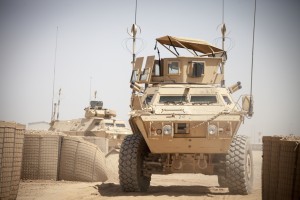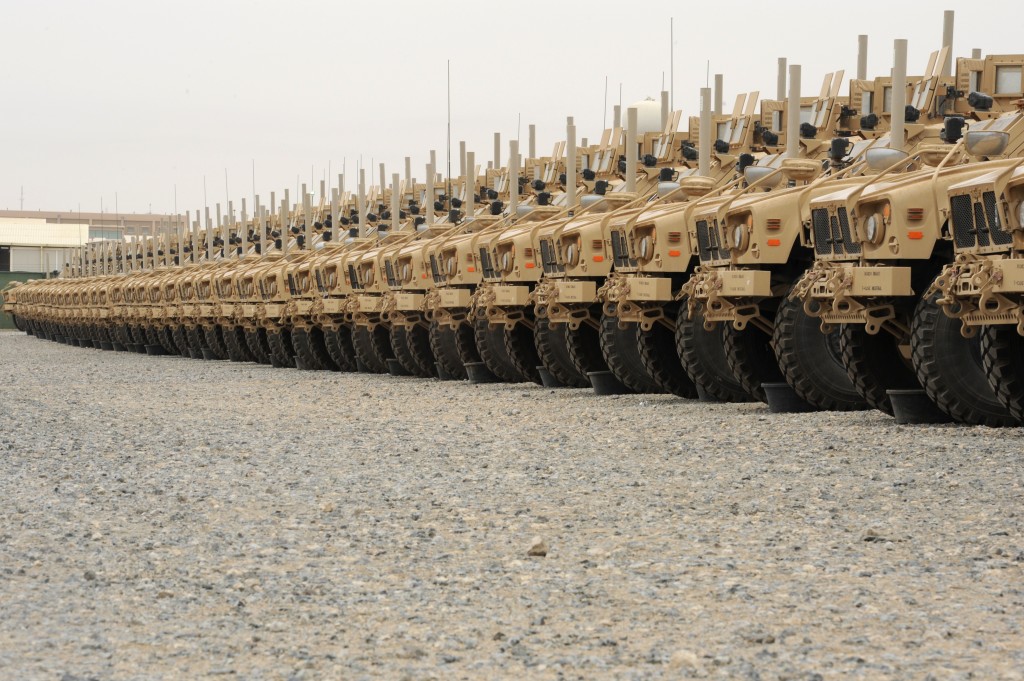Why Spend $887 Million on Armored Vehicles for Afghan Army When Thousands Sit Idle?
A single line item in the latest quarterly report from SIGAR (pdf) has my blood boiling. The report states that among the up to $7.73 billion that the Defense Department has requested for fiscal 2014 in Afghanistan, a single item of $886.9 million is listed as being for Mobile Strike Force Vehicles. A quick look with teh Googler gives us this page where we see details on just what the Mobile Strike Force Vehicle is. A Marine Corps photo of an MSFV appears here to the left. Here is the caption that the Marine Corps provided for the photo on Flickr:
Cpl. Damario Tillman, vehicle commander, Mobile Strike Force Advisor Team, observes his surroundings as a Mobile Strike Force Vehicle assigned to the Afghan National Army (ANA) Mobile Strike Force Kandak, navigates through a series of obstacles at a rough terrain driving course on Camp Bastion, Helmand province, Afghanistan, May 13, 2013. The course was part of a three day training package that the Marines with Mobile Strike Force Advisor Team conducted for their ANA counterparts.
The stupidity of spending nearly a billion dollars on new armored vehicles for Afghanistan is mind-boggling. I have been haunted for several months by this photo:
Here is the caption provided by the Defense Video & Image Distribution System where the photo can be found:
Mine-Resistant Ambush Protected vehicles wait in a staging area for onward movement at an undisclosed base in Southwest Asia March 20, 2013. The joint team of Marines, soldiers, sailors and airmen of the Central Command’s DDOC will play a major role in moving the more than 50,000 Coalition (U.S. and NATO, of which 28,000 are U.S.) military vehicles in Afghanistan that will need to be recovered or pre-positioned in contingency stocks abroad.
Although I am far from an expert on defense equipment, it appears to me that the MSFV is merely the latest version in the wide array of MRAP vehicles. Here is a snippet from a press release relating one of the major purchases of MSFV’s:
Part of the TM&LS COMMANDO Select line of armored vehicles, the MSFV is derived from the combat-proven M1117 Armored Security Vehicle (ASV). All MSFVs are configured with Enhanced Survivability (ES) capability, which increases blast protection to mine-resistant, ambush-protected (MRAP) levels. The ES-equipped vehicles continue to possess the ASV’s original, all-important V-shaped hull design, in addition to innovative protection design features that enable them to meet MRAP blast protection standards.
Note that the date given for the photo of MRAP’s that have already been shipped out of Afghanistan is March 20 of this year. It would appear that the Defense Department is engaging in a bit of misinformation to make it look like there isn’t an excess of usable MRAP’s, given this Marine Corps Times article dated less than a week later on March 26. The title of the article is “Most MRAP’s won’t be coming home from Afghanistan” and it is accompanied by this photo of several disheveled, out of service MRAP’s that look nothing like the shiny, functional ones already shipped out of the country in the March 20 photo.

The Marine Corps wants us to think this is what the MRAP’s in Afghanistan look like so that we can send new MSFV’s to the ANA.
The article states:
Very few of the Marine Corps’ 1,200 mine-resistant ambush-protected vehicles still in Afghanistan will be traveling back to the U.S., the Corps’ deputy commandant for installations and logistics said this week.
Speaking at the Potomac Institute for Policy Studies Wednesday afternoon, Lt. Gen. William Faulkner revealed elements of a plan to donate unwanted MRAPs to partner nations within Central Command as Marines balance efforts to retrograde from Afghanistan with a mandate to get lighter and more compact as a service.
“The bottom line is, we don’t need them,” Faulkner said of the MRAPs remaining in Afghanistan. “We don’t need as many as we have today.”
/snip/
The Marine Corps has about 4,000 MRAPs in its inventory, Faulkner said, and officials have calculated they want to keep fewer than 1,500 of the 14-ton machines after Operation Enduring Freedom draws to a close in 2014.
So the Marines have an excess of 2500 MRAP’s and Faulkner even admits we want to give them away. So why haven’t these MRAP’s been donated to the ANA instead of the US sending them brand new MSFV’s?



As so often, I’m assuming the answer has to do with jobs in someone’s Congressional district or $$$ to a key member of the House or Senate…
“So why haven’t these MRAP’s been donated to the ANA instead of the US sending them brand new MSFV’s?”
too busy bringing them back to the usa and donating them to local cops:
The Livingston County Sheriff’s Department has acquired a Mine-Resistant Ambush-Protected (MRAP) vehicle for its tactical team through the military’s Defense Reutilization and Marketing Office, which is managed by the Defense Logistics Agency. The office takes military equipment that is no longer usable and “demilitarizes” it, making it available to law enforcement agencies nationwide.
http://www.livingstondaily.com/apps/pbcs.dll/article?AID=2013307180005
Reader unhappy with sheriff’s vehicle
The Livingston County Sheriff’s Department has received a huge military vehicle to use during high-risk situations.
This new vehicle is called the Mine-Resistant Ambush Protected Vehicle (MRAP).
As President Barack Obama has stated, “weapons of war do not belong on our streets.”
This MRAP is clearly a “weapon of war,” to be used against US citizens.
It is the job of the sheriff to protect our constitutional rights, not to be a paramilitary force. The excuse for this is 9/11, the “go-to” reason for any encroachment on our liberties. The job of the sheriff is to stand as a barrier to such actions and protect the citizens’ rights, not take part in these tyrannical oversteps.
It is a sad day when our sheriffs feel the need to have “weapons of war” to do their jobs.
http://www.livingstondaily.com/article/20130721/OPINION03/307210017/Reader-unhappy-sheriff-s-vehicle
Well, you know that the market value drops the minute you drive it off the lot. Only the best for our Afghan hosts.
Welcome back, Jim. That was one awesome looking vacation spot you showed on Twitter. I need to get your email to find out more info about it for my fiance. Hope you had nice weather and a great time. Lots of weird things going on in Afghanistan while you were gone. Will be looking forward to your posts to help me understand them better. Don’t know what I’d do without you and Garrett.
Wait! This makes no sense! In June the Washington Post was reporting on us shredding and selling for scrap tons of those things in Afghanistan. It was in the “News of AfPak” segment of Harry Shearer’s June 23 Le Show:
I found the article: http://www.washingtonpost.com/world/asia_pacific/scrapping-equipment-key-to-afghan-drawdown/2013/06/19/9d435258-d83f-11e2-b418-9dfa095e125d_story.html
It goes on to talk specifically about MRAPs:
What’s 2,000 x $1 million? $2 billion? Someone should tell someone?
Your top photo is Helmand province – there was this in the June 2 Le Show:
“We could have just given them the money.” Someone should tell someone?
@thatvisionthing: Really infuriating, isn’t it? I can’t find anything to suggest that these new MSFV’s are anything more than just this year’s model of the MRAP. Scapping and/or hiding thousands of these at a million bucks apiece while ordering almost another billion dollars’ worth of new ones really drives home how the only ones who are profiting from this misadventure are the defense contractors.
Late in the day Friday, I asked the Pentagon Press Secretary (on Twitter) whether he could answer the questions posed in this post. Crickets so far…
@Jim White: : I wonder what they’re paying in compensation per Afghani life they admit was wrongfully killed? As measured in MRAPs. Does it take a village? Tell me when we win.
Question for Pentagon Press Secretary.
Anyone who follows me or my blog knows that I’m no fan of how the DoD is prosecuting this war, but in this instance, I’m actually going to step in and say that this move makes sense.
Yes, at first blush these just seem like this year’s MRAP, but they’re not: these are slightly improved versions of the vehicle that (in the Army at least) MPs have been rolling around in for years. So it’s not a brand new vehicle, just an upgrade, like they did with the HMMWVs once upon a time.
The MRAP is the worst possible vehicle for the agile movement required in most of Afghanistan: it was a mistake for the US to purchase them, and an even greater mistake to give them to the Afghans. In this regard the M1117 makes more sense.
Another reason the M1117 makes sense is cost: maintaining and running the MRAP behemoth would be prohibitively expensive for the Afghan military. All indications are that they’re going to struggle with the vehicles they are getting, but the MRAP is very much a 1st world vehicle that’s outside the capabilities of the Afghans to maintain.
What’s troubling is the large number of unarmored vehicles we’re buying for the Afghans in a threat environment still saturated with IEDs. Ranger pickups are no match for what the insurgency keeps putting in the roadways.
So while there are many reasons to criticize US efforts in Afghanistan, this isn’t one of them.
@Gary Owen: Thanks for that. I was a bit worried that there might be something like this behind it, but I’m dubious that Afghan forces will be able to maintain any equipment, no matter how complicated or simplified it is. It still comes off as more pointless wasted money, effort and lives to me.
@Jim White: Pretty sure whatever gear we leave behind is going to be idle within 18-24 months after we walk out the door, given ISAF’s lack of focus on a) logistics b) maintenance over the years. It was a conscious decision to bulk up the ANSF’s fighting abilities, but it’s going to mean that they really can’t handle much beyond those basic combat skills long-term.